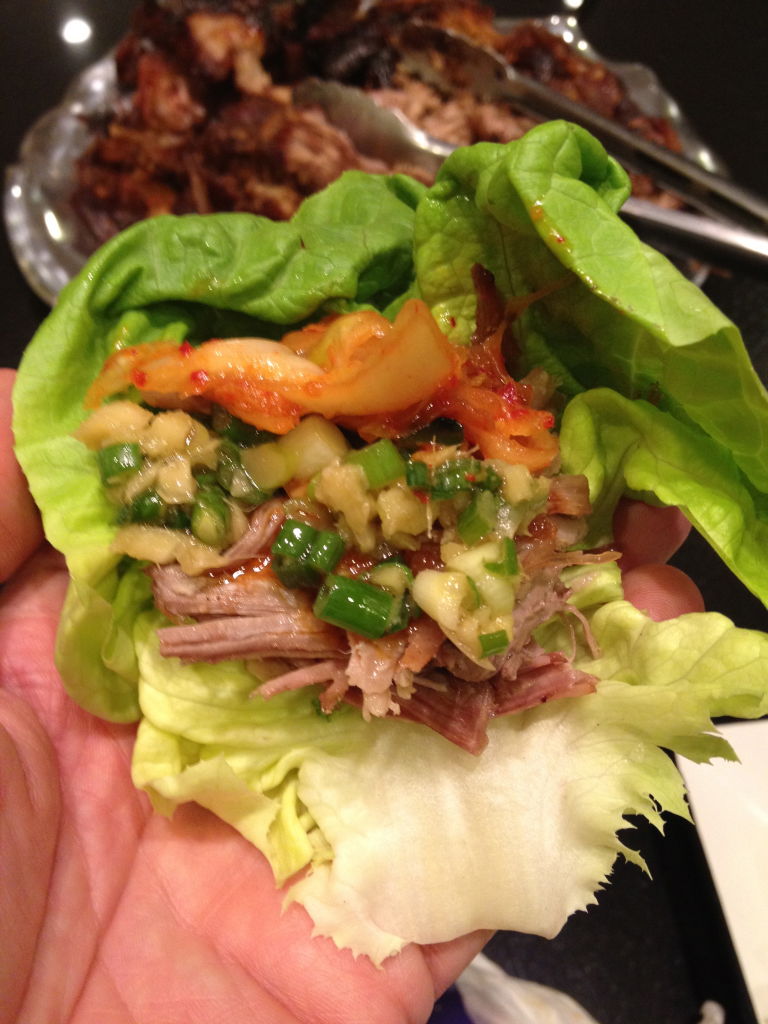
DIY Bo Ssam a la David Chang

Every Sunday, I look through the New York Times’ Magazine, always making a note to check out the food column. I’ll typically save the issue if it’s something interesting, but I rarely get around to actually making the featured recipe(s). A few weeks ago, however, I hung on to the January 15th issue and made a note to attempt the recipe, since it contained a few things that really resonated with me: kimchi, roast pork and David Chang.
I’ve been to Chang’s Momofuku Ssäm Bar in New York a couple of times, and while the guy probably gets far more press attention than he deserves, I will admit that the idea of making his bo ssam recipe hooked me. I had tried it once, at the annual Food & Wine Classic in Aspen; Chang had been a panelist at the Trade Program, while I was the moderator. At the big shindig for the speakers and their guests that weekend, he assembled a bo ssam spread, complete with roasted pork, raw oysters, a fiery kimchi sauce and lots of steamed rice and lettuce leaves. I never considered how (relatively) easy this could be to make, but after I read through the Times’ adaptation by Sam Sifton, I knew the biggest challenge I would have would be to procure a beautiful, 8 to 10 pound pork shoulder.
At Momfuku, you can purchase a bo ssam experience for a tidy $200; it serves six to 10 people and requires advance notice. But with just a few days before having some guests over for dinner, I decided I could make this spread myself, especially since Sifton laid out the recipe so easily in the Magazine.
My first task, track down the pork. I called a friend who works with Niman Ranch producers, and she found me a well-marbled 10 pound boneless pork shoulder. The recipe calls for a bone-in pork butt or picnic ham, but a boneless shoulder does the trick. Just combine a cup each of sugar and salt, then rub it all over the pork and put it into the fridge, covered in plastic wrap, overnight. The next day, place the pork in a roasting pan and put it into a 300 degree oven. After six hours, it will look like this:
I took the pork out to rest a bit, meanwhile, I got some rice going in the rice cooker, cleaned some bibb lettuce leaves and opened a container of kimchi I got from Bill Kim at Belly Shack. Then I made my sauces.
You only need to make two sauces for this recipe: a ginger-scallion (pictured below, left) and a ssam sauce (right), which contains two types of Korean pastes. For the ginger-scallion, you simply mince up some fresh ginger, finely-chop some scallions, then add a neutral oil, like grapeseed, along with some sherry vinegar and light soy sauce. I put it together in about four minutes.
The ssam sauce is even easier, but it requires buying two Korean pastes that I found at the Joong Boo Market on the Northwest Side, right off the Kennedy Expressway. One is kochujang (Korean chili paste), the other is ssamjang (fermented bean and chili paste). You use the same sherry vinegar and grapeseed oil in this one as well.

The final step happens when your guests come over. Crank the oven to 500, then coat the pork shoulder with seven tablespoons of brown sugar and one tablespoon of salt. This will caramelize the outer shell of fat (most of which has been rendered off over the course of those six hours) and will only take 10 to 15 minutes. As soon as you remove the pork from the oven, place it on the table with the rice, kimchi, sauces and lettuce cups, and have at it.






This recipe needs to include more specific information to be useful.
After marinating overnight, do you pour off juices, remove rub? Or leave as is and bake?
I removed juices as in other Momofuko recipes… and left rub.
After 6 hours @ 300 degrees, the drippings were WAY TOO SALTY,…Using Diamond Crystal Salt…that is a scarce and expensive commodity during this stay in place time ($6 per 3# pkg + $12 shipping!!!!) I-used my last bit to try this recipe)
The result is WAY TOO SALTY!
Applied the brown sugar….but time was not included in this recipe.
Please be specific with your instruction.
I’m so sorry to hear this. After the dry cure overnight, you just remove the pork butt from the bowl and place onto roasting pan – discard the slurry that has formed in the bowl. Not sure why you used Diamond Crystal, just plain old kosher salt is the default; I only use Morton’s. But I think a 1/2 cup mixture of salt-sugar for the dry brine would be sufficient, rather than the 1 cup of each the recipe calls for. Once you apply the brown sugar + 1 Tbsp salt at the end, and blast oven to 500, just goes in for about 10 min. until the skin/fat starts to bubble.
One thing I should also mention, you want to get a pork butt with a little fat cap on the top – it shouldn’t be completely trimmed. When you place the pork in oven – fat side up – that will melt and render into the pork butt which will help with the pan juices.